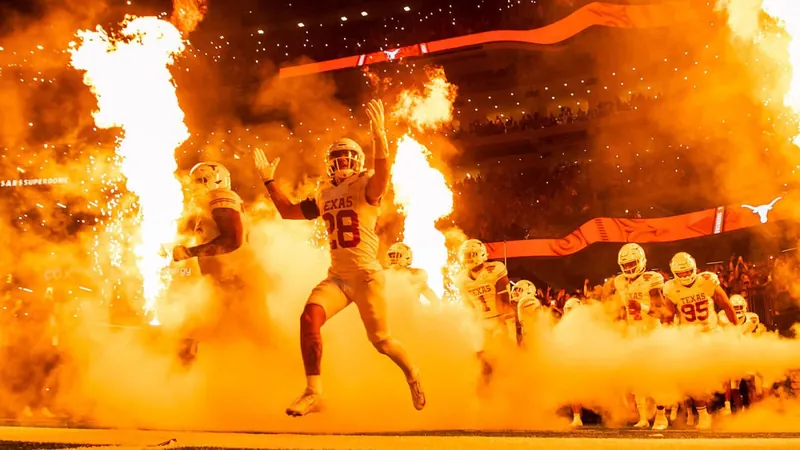
The Game-Changer: How Revenue Sharing is Set to Transform College Athletics Forever!
2024-11-20
Author: Ling
Introduction
In a groundbreaking shift in college sports, whispers have surfaced that Brigham Young University (BYU) is eyeing a lucrative $3 million to $4 million deal through name, image, and likeness (NIL) agreements for AJ Dybantsa, the highly-coveted No. 1 recruit of the Class of 2025. Not only BYU, but fierce competition from elite programs like Kansas and Kansas State underscores the urgency of this evolving landscape.
The Significance of the Potential Payday
How significant is this potential payday? This staggering amount could mark the highest compensation ever offered to a college basketball player. However, the financial viability of such commitments raises eyebrows among administrators, highlighting potential pitfalls. One blue-blood program administrator remarked, “You can't spend $4 million on one player and still expect quality teammates. At that rate, you’d be left ‘playing with four dogs.’”
The Revenue Sharing Era
This commentary reflects a broader concern as college athletics stands on the verge of what is being called the revenue-sharing era. With the possibility of a formal agreement in April regarding the House v. NCAA settlement, anticipation looms large. Revenue sharing is projected to unlock an annual infusion of $20.5 million, paving the way for a pay-for-play model that has long been debated.
Voices from the Industry
Sedona Prince, a prominent voice in women’s basketball and one of the plaintiffs in the House case, proclaimed, "This is how college sports should function moving forward. The foundation is changing forever!" The financial breakdown suggests that football will dominate the allocation, receiving between $10 million to $15 million annually per institution, while men’s basketball is set to garner $2 million to $4 million, squeezing out lesser funding for women’s sports and other minor athletic programs.
The ‘Four Dogs’ Dilemma
As the dust begins to settle on this seismic shift, teams must grapple with the “four dogs” dilemma—how to allocate limited resources while raising their competitiveness. The fragmentation of college sports into mega-conferences has become increasingly clear, particularly as the SEC and Big Ten stand ready to seize upon revenue-sharing advantages that amplify their recruiting prowess and overall influence.
Disparities and Challenges Ahead
The landscape is already creating disparities: Group of Five schools (Sun Belt, American, Conference USA, Mountain West, and MAC) face an uphill battle to remain relevant. As Power Four conferences become more entrenched in their resources, those in the middle like the ACC and Big 12 find themselves in a precarious balancing act of fully adopting revenue-sharing measures.
Rising Financial Pressures
Financial pressures are mounting. Bill Self, the head coach of Kansas basketball, spoke candidly about the troubling implications of revenue-sharing on athletic departments: “Where is that money going to come from? You’re going to keep hitting up donors for NIL.”
A Culture of Secrecy
With some institutions unsure of how they will implement or fund this new system, a culture of secrecy surrounding revenue-sharing intentions is beginning to take root. Coaches are being tight-lipped; for instance, Arizona State's Kenny Dillingham recently stated that strict orders prevented him from discussing funding strategies.
The Role of ‘General Managers’
Additionally, the role of “general managers” within college programs is emerging—individuals designated to oversee budget allocations and salary distribution among athletes, drawing inspiration from NFL team management. Texas Tech's GM, James Blanchard, highlighted the growing resemblance between college football and the NFL in operational strategies, admitting, “College football is about 50-60 years behind, but it’s finally catching up.”
Concerns Over Title IX Compliance
As the NCAA grapples with these substantial shifts, critics are wary of looming Title IX complaints that might arise from discrepancies in gender equity regarding the distribution of revenue. Furthermore, recent developments hint at a cultural shift where schools might opt for drastic measures, such as not fully funding all sports, an option Ohio State briefly considered before choosing a different direction.
Colossal Implications
The implications of these evolving structures are colossal. Beyond potential budget cuts, the separation between powerhouse programs and lesser-funded schools might eventually fuel calls for a complete overhaul of governance within Division I sports.
Conclusion
With the clock ticking down towards a new era—marked by revenue sharing—college athletics is on the cusp of transformational changes that will define its future trajectory. As the age-old question lingers—who will be in and who will be out—the stakes have never been higher. The impending decisions will not just shape rosters but also the very essence of college sports as we know it. Buckle up; this is just the beginning!






 Brasil (PT)
Brasil (PT)
 Canada (EN)
Canada (EN)
 Chile (ES)
Chile (ES)
 España (ES)
España (ES)
 France (FR)
France (FR)
 Hong Kong (EN)
Hong Kong (EN)
 Italia (IT)
Italia (IT)
 日本 (JA)
日本 (JA)
 Magyarország (HU)
Magyarország (HU)
 Norge (NO)
Norge (NO)
 Polska (PL)
Polska (PL)
 Schweiz (DE)
Schweiz (DE)
 Singapore (EN)
Singapore (EN)
 Sverige (SV)
Sverige (SV)
 Suomi (FI)
Suomi (FI)
 Türkiye (TR)
Türkiye (TR)